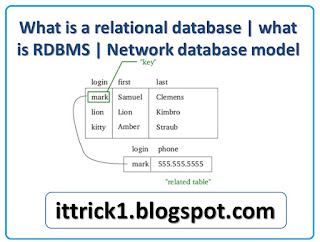what is a relational database | what is RDBMS | network database model
 |
| what is a relational database what is RDBMS | network database model |
Database model
There are a couple of ways to describe a database model. Some
say that it is a type of data model that determines and is concern about the logical structure of a database and basically determines in which way data
can be stored, organized and manipulated. In this article, I am going to discuss
a lot of form of database model but the most popular and most important example
of a database model is the relational model, which uses a table-based format. One can also describe a database model as the
logical structure, representation or layout of a database and how the data will
be stored, managed and processed within it. It is the most important tool for
the database administrators while designing a database and application
developers also use it.
Most data models can
be represented by an accompanying database diagram. These database diagrams are
the most significant elements and a must-learn skill to learn. Database models
are of a wide variety, I am going to tell you some of the database models. Hierarchical
database model, Relational model, Network model, Object-oriented database
model, Entity-relationship model, Document model, Entity-attribute-value model,
Star schema are some of the most common and wildly used types of a database
model. We are going to discuss all of these types one by one. Selection of a
data model is also a matter of your priorities, each database model has its own
benefits like speed, cost reduction, and many others.
Relational model
The relational model was introduced by E.F. Codd in 1970. It
is a mathematical model defined in terms of predicate logic and set theory, and
implementations of it have been used by mainframe, midrange and microcomputer
systems. It is the most common model in
use, the relational model arranges data into tables, also known as relations,
each of which contains columns and rows. A relation is a table with columns and
rows. The named columns of the relation are called attributes, and the domain
is the set of values the attributes are allowed to take.
The basic data structure of the relational model is the
table, where information about a particular entity is represented in rows and
columns. So, the "relation" in "relational database"
refers to the various tables in the database; a relation is a set of tuples.
The columns identify the various qualities of the entity which includes the
name, home address, and many other information about a person and a row is an actual instance of the entity which specifies a particular person that is
represented by the relation. The most common query language used with the
relational model is the Structured Query Language (SQL).
Network model
A network model is a database model that is designed as a
flexible approach to representing objects and their relationships. A unique
feature of the network model is its schema, which is viewed as a graph where
relationship types are arcs and object types are nodes. Unlike other database
models, the network model's schema is not confined to be a lattice or
hierarchy; the hierarchical tree is replaced by a graph, which allows for more
basic connections with the nodes. There are certain drawbacks of the network model which includes
a very complex system, it is difficult to be maintained because we have to use a pointer to manage things which can make matter extremely difficult and one needs
to be an expert to use this tool. There is another drawback n it has which is
functional Flaws that functional flaws are because a great number of pointers
is essential, insertion, updates, and deletion become more complex. There is
another thing that its structure is not independent.
Hierarchical database model
One can describe the hierarchical database is a design that uses
a one-to-many relationship for data elements. The hierarchical model organizes
data into a tree-like structure, where each record has a single parent or root.
Sibling records are sorted in a particular order. That order is used as the
physical order for storing the database.
This model has its own benefits and one of these is that this model is
very important and reliable for describing many real-world relationships. But it
has a drawback that it is not very versatile.












No comments
Note: Only a member of this blog may post a comment.